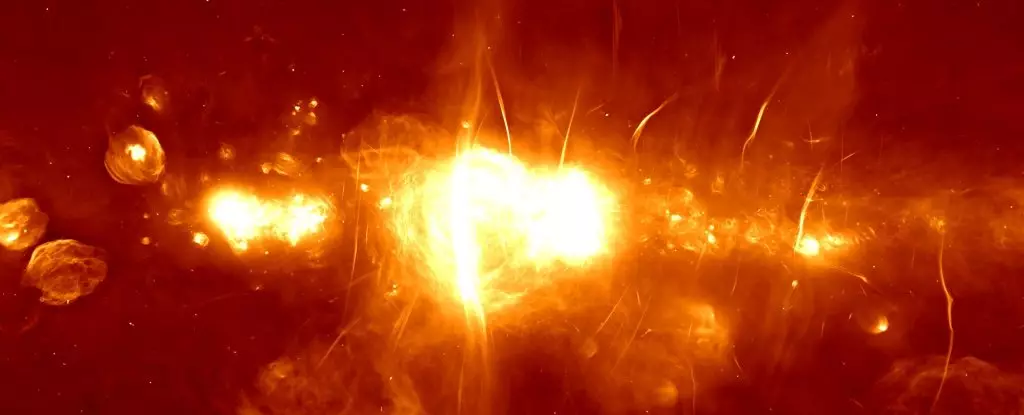As we venture deeper into the enigmas of the cosmos, a recent discovery at the heart of the Milky Way has set the astronomical community abuzz. Within the Central Molecular Zone (CMZ), where chaos intertwines with beauty, astronomers have unveiled a peculiar array of structures—long, thin filaments of gas that can be likened to cosmic tornadoes. This groundbreaking observation sheds light on the dynamic and often tumultuous life surrounding our galaxy’s supermassive black hole.
Leading this intriguing exploration is a team of astronomers, spearheaded by renowned physicist Kai Yang from Shanghai Jiao Tong University. Their research dives into the core of the CMZ, a region brimming with dense clouds of dust and molecular gas that seem to pulsate with violent energy. Measuring a staggering 2,000 light-years and housing roughly 80% of the Milky Way’s dense gas, the CMZ is a swirling vortex of activity, challenging our understanding of stellar formation and galactic dynamics.
The Anatomy of Slim Filaments
Using the powerful capabilities of the Atacama Large Millimeter/submillimeter Array (ALMA), the researchers sought to elucidate the complexities of the CMZ’s environment. Traditionally, the study of this region has been met with substantial challenges due to its opaqueness; the thick clouds obscure observational clarity. However, Yang and his associates cunningly focused their investigation on silicon monoxide, an elemental trace that has proven instrumental in mapping shock waves within the galactic fabric.
What they uncovered, however, transcended their initial expectations. The team identified not merely filaments, but “slim filaments,” characterized by their elongated shapes and odd location away from established star-forming regions. These filaments represent a paradigm shift in understanding gas dynamics in our galaxy. Unlike conventional filaments typically found in other molecular clouds, the slim filaments emerge powered by turbulent pressures. They function similarly to tornadoes—volatile yet critical conduits for matter.
Churning Gas and Galactic Recycling
Complex molecules populate these thin filaments, including cyclopropenylidene, formaldehyde, and methanol, pushing the boundaries of our understanding of molecular chemistry in the cosmos. Researchers surmise that shocks, generated by collisions within the CMZ, contribute significantly to the formation of these filaments. As these shocks energize the gas, they precipitate the creation and distribution of molecular-rich material that underpins the CMZ’s chaotic splendor.
Understanding these slim filaments could revolutionize our comprehension of the recycling processes within the CMZ. The scientists speculate that they may play a remarkable role in the matter distribution and circulation throughout this region. As they dissipate, they efficiently disseminate materials back into the galactic environment, much like tornadoes on Earth redistribute matter across the landscape. This stirring revelation suggests that galactic dynamism is not merely a backdrop for star formation but an active player in shaping the universe.
A Shift in Galactic Dynamics
The implications of identifying slim filaments extend well beyond the immediate observational findings. In a world where the interstellar medium is perceived as a static backdrop, this discovery posits that we must reconsider our models of gas dynamics and stellar evolution within galaxies.
Interestingly, astronomers have long grappled with understanding the physical processes that propel material through the CMZ. By examining the behaviors and roles of these newly identified structures, researchers can better model the interactions between shocks and molecular clouds. This represents a significant leap forward for astrophysics, encouraging an invigorated spirit of inquiry into not just the Milky Way, but other galaxies that may boast similar chaotic yet beautiful environments.
As we continue to peel back the layers surrounding galactic mechanics, the narrative of the cosmos becomes richer and more complex. The slim filaments serve as a testament to the intricate relationships that govern stellar and molecular interactions beyond our immediate sight. In essence, these cosmic tornadoes aren’t merely fascinating anomalies; they are pivotal actors in the grand cosmic play of evolution and material distribution in galaxies.
The world of astrophysical study is sharpening its lens, encouraged by these revelations, and we find ourselves on the precipice of understanding the fabric of the universe in deeper, more profound ways. The elegance of the CMZ’s turbulence merits further exploration, promising not only answers to existing questions but also the ignition of new ones in our unending quest to comprehend our place in the cosmos.


Leave a Reply